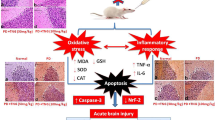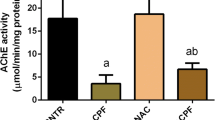Abstract
Paraquat (PQ), as a widely used herbicide, enhances the formation of free radicals and oxidative stress. Cerium oxide nanoparticles (CeNPs) are one of the most utilized and effective nanoparticles having strong antioxidative properties and inhibiting free radicals. Here, we aimed to investigate the effects of CeNPs on brain oxidative toxic stress injury induced with PQ. The male rats were treated intraperitoneally daily with PQ (50 mg/kg/day) and CeNPs (15, 30, and 60 mg/kg/day) alone or in combination for 2 weeks. After treatments, the brain tissue samples were collected. Oxidative toxic stress biomarkers including lipid peroxidation (LPO), total antioxidant capacity (TAC), and total thiol molecules (TTM) as well as DNA damage and caspase-3 levels were measured. Moreover, the mRNA expression levels of Nestin and Neurod1 were assayed. Our results showed that PQ has significantly increased brain LPO, DNA damage, and caspase-3 levels and further reduced TAC and TTM contents, as well as expression levels of Nestin and Neurod1, compared with the control group (injection of saline). CeNPs (15- and 30-mg/kg doses) in groups co-administered with PQ significantly ameliorated the LPO, DNA damage, and caspase-3 levels while increasing TAC and TTM contents as well as enhancing Nestin and Neurod1 mRNA expression levels in the brain samples (P < 0.05). These findings suggest a neuroprotective and antioxidant role for CeNPs in PQ-induced brain injury. However, further studies are required to clarify its clinical/pharmacological significance.







Similar content being viewed by others
References
Alaraby M et al (2015) Antioxidant and antigenotoxic properties of CeO2 NPs and cerium sulphate: studies with Drosophila melanogaster as a promising in vivo model. Nanotoxicology 9:749–759
Amirshahrokhi K, Bohlooli S (2013) Effect of methylsulfonylmethane on paraquat-induced acute lung and liver injury in mice. Inflammation 36:1111–1121
Ayala A, Muñoz MF, Argüelles S (2014) Lipid peroxidation: production, metabolism, and signaling mechanisms of malondialdehyde and 4-hydroxy-2-nonenal. Oxidative Med Cell Longev 2014
Bailey ZS et al. (2016) Cerium oxide nanoparticles improve outcome after in vitro and in vivo mild traumatic brain injury. J Neurotrauma
Benzie IF, Strain J (1999) [2] Ferric reducing/antioxidant power assay: direct measure of total antioxidant activity of biological fluids and modified version for simultaneous measurement of total antioxidant power and ascorbic acid concentration. In: Methods in enzymology, vol 299. Elsevier, pp 15–27
Bernal A, Arranz L (2018) Nestin-expressing progenitor cells: function, identity and therapeutic implications. Cell Mol Life Sci 1–19
Bradford MM (1976) A rapid and sensitive method for the quantitation of microgram quantities of protein utilizing the principle of protein-dye binding. Anal Biochem 72:248–254
Caputo F et al (2015) Cerium oxide nanoparticles, combining antioxidant and UV shielding properties, prevent UV-induced cell damage and mutagenesis. Nanoscale 7:15643–15656
Chen B-H, Stephen Inbaraj B (2018) Various physicochemical and surface properties controlling the bioactivity of cerium oxide nanoparticles. Crit Rev Biotechnol 1–22
Chen J, Patil S, Seal S, McGinnis JF (2006) Rare earth nanoparticles prevent retinal degeneration induced by intracellular peroxides. Nat Nanotechnol 1:142
Chen J-L et al (2015) Methylene blue attenuates acute liver injury induced by paraquat in rats. Int Immunopharmacol 28:808–812
Colon J et al (2009) Protection from radiation-induced pneumonitis using cerium oxide nanoparticles. Nanomedicine 5:225–231
Colon J, Hsieh N, Ferguson A, Kupelian P, Seal S, Jenkins DW, Baker CH (2010) Cerium oxide nanoparticles protect gastrointestinal epithelium from radiation-induced damage by reduction of reactive oxygen species and upregulation of superoxide dismutase 2. Nanomedicine 6:698–705
Cui D et al (2014) Effect of cerium oxide nanoparticles on asparagus lettuce cultured in an agar medium. Environ Sci Nano 1:459–465
Das M, Patil S, Bhargava N, Kang J-F, Riedel LM, Seal S, Hickman JJ (2007) Auto-catalytic ceria nanoparticles offer neuroprotection to adult rat spinal cord neurons. Biomaterials 28:1918–1925
Erdakos GB, Bhave PV, Pouliot GA, Simon H, Mathur R (2014) Predicting the effects of nanoscale cerium additives in diesel fuel on regional-scale air quality. Environ Sci Technol 48:12775–12782
Estevez A et al (2011) Neuroprotective mechanisms of cerium oxide nanoparticles in a mouse hippocampal brain slice model of ischemia. Free Radic Biol Med 51:1155–1163
Fu X, Shen Y, Wang W, Li X (2018) MiR-30a-5p ameliorates spinal cord injury-induced inflammatory responses and oxidative stress by targeting Neurod 1 through MAPK/ERK signalling. Clin Exp Pharmacol Physiol 45:68–74
Gao Z et al (2009) Neurod1 is essential for the survival and maturation of adult-born neurons. Nat Neurosci 12:1090
Heckman KL et al (2013) Custom cerium oxide nanoparticles protect against a free radical mediated autoimmune degenerative disease in the brain. ACS Nano 7:10582–10596
Hendrickson ML, Zutshi I, Wield A, Kalil RE (2018) Nestin expression and in vivo proliferative potential of tanycytes and ependymal cells lining the walls of the third ventricle in the adult rat brain. Eur J Neurosci 47:284–293
Hosseini A et al (2015) Cerium and yttrium oxide nanoparticles against lead-induced oxidative stress and apoptosis in rat hippocampus. Biol Trace Elem Res 164:80–89
Hu M, Dillard C (1994) Plasma SH and GSH measurement. Methods Enzymol 233:87
Islam MT (2017) Oxidative stress and mitochondrial dysfunction-linked neurodegenerative disorders. Neurol Res 39:73–82
Jomova K, Vondrakova D, Lawson M, Valko M (2010) Metals, oxidative stress and neurodegenerative disorders. Mol Cell Biochem 345:91–104
Khanam R et al. (2018) Piperazine clubbed with 2-azetidinone derivatives suppresses proliferation, migration and induces apoptosis in human cervical cancer HeLa cells through oxidative stress mediated intrinsic mitochondrial pathway. Apoptosis 1–19
Korsvik C, Patil S, Seal S, Self WT (2007) Superoxide dismutase mimetic properties exhibited by vacancy engineered ceria nanoparticles. Chem Commun 1056–1058
Livak KJ, Schmittgen TD (2001) Analysis of relative gene expression data using real-time quantitative PCR and the 2− ΔΔCT method. Methods 25:402–408
Ma W, Jing L, Valladares A, Mehta SL, Wang Z, Li PA, Bang JJ (2015) Silver nanoparticle exposure induced mitochondrial stress, caspase-3 activation and cell death: amelioration by sodium selenite. Int J Biol Sci 11:860
McCormack AL, Atienza JG, Johnston LC, Andersen JK, Vu S, Di Monte DA (2005) Role of oxidative stress in paraquat-induced dopaminergic cell degeneration. J Neurochem 93:1030–1037
Ming G-L, Song H (2011) Adult neurogenesis in the mammalian brain: significant answers and significant questions. Neuron 70:687–702
Morán JM, Ortiz-Ortiz MA, Ruiz-Mesa LM, Fuentes JM (2010) Nitric oxide in paraquat-mediated toxicity: a review. J Biochem Mol Toxicol 24:402–409
Naseri S, Moghahi SMHN, Mokhtari T, Roghani M, Shirazi AR, Malek F, Rastegar T (2017) Radio-protective effects of melatonin on subventricular zone in irradiated rat: decrease in apoptosis and upregulation of Nestin. J Mol Neurosci 63:198–205
Nazıroğlu M, Şenol N, Ghazizadeh V, Yürüker V (2014) Neuroprotection induced by N-acetylcysteine and selenium against traumatic brain injury-induced apoptosis and calcium entry in hippocampus of rat. Cell Mol Neurobiol 34:895–903
Nelson BC, Johnson ME, Walker ML, Riley KR, Sims CM (2016) Antioxidant cerium oxide nanoparticles in biology and medicine. Antioxidants 5:15
Niu J, Azfer A, Rogers LM, Wang X, Kolattukudy PE (2007) Cardioprotective effects of cerium oxide nanoparticles in a transgenic murine model of cardiomyopathy. Cardiovasc Res 73:549–559
Niu J, Wang K, Kolattukudy PE (2011) Cerium oxide nanoparticles inhibits oxidative stress and nuclear factor-κB activation in H9c2 cardiomyocytes exposed to cigarette smoke extract. J Pharmacol Exp Ther 338:53–61
Nunes ME et al (2017) Chronic treatment with paraquat induces brain injury, changes in antioxidant defenses system, and modulates behavioral functions in zebrafish. Mol Neurobiol 54:3925–3934
Oberdörster G, Elder A, Rinderknecht A (2009) Nanoparticles and the brain: cause for concern? J Nanosci Nanotechnol 9:4996–5007
Özel RE, Hayat A, Wallace KN, Andreescu S (2013) Effect of cerium oxide nanoparticles on intestinal serotonin in zebrafish. RSC Adv 3:15298–15309
Pourkhalili N et al (2011) Biochemical and cellular evidence of the benefit of a combination of cerium oxide nanoparticles and selenium to diabetic rats. World J Diabetes 2:204
Rajeshkumar S, Naik P (2017) Synthesis and biomedical applications of cerium oxide nanoparticles–a review. Biotechnol Rep
Rzigalinski BA, Meehan K, Davis RM, Xu Y, Miles WC, Cohen CA (2006) Radical nanomedicine
Rzigalinski BA, Carfagna CS, Ehrich M (2017) Cerium oxide nanoparticles in neuroprotection and considerations for efficacy and safety. Wiley Interdisciplinary Reviews: Nanomedicine and Nanobiotechnology 9:e1444
Sadhu A, Ghosh I, Moriyasu Y, Mukherjee A, Bandyopadhyay M (2018) Role of cerium oxide nanoparticle-induced autophagy as a safeguard to exogenous H2O2-mediated DNA damage in tobacco BY-2 cells. Mutagenesis 33:161–177
Sahlgren CM, Pallari HM, He T, Chou YH, Goldman RD, Eriksson JE (2006) A Nestin scaffold links Cdk5/p35 signaling to oxidant-induced cell death. EMBO J 25:4808–4819
Tarnuzzer RW, Colon J, Patil S, Seal S (2005) Vacancy engineered ceria nanostructures for protection from radiation-induced cellular damage. Nano Lett 5:2573–2577
Uittenbogaard M, Baxter KK, Chiaramello A (2010) The neurogenic basic helix-loop-helix transcription factor NeuroD6 confers tolerance to oxidative stress by triggering an antioxidant response and sustaining the mitochondrial biomass. ASN Neuro 2:AN20100005
Xu C, Qu X (2014) Cerium oxide nanoparticle: a remarkably versatile rare earth nanomaterial for biological applications. NPG Asia Mater 6:e90
Yagi K (1998) Simple assay for the level of total lipid peroxides in serum or plasma. In: Free radical and antioxidant protocols. Springer, pp 101–106
Yang B, Mei H, Zuo F, Gan L (2017) Expression of microRNAs associated with oxidative stress in the hippocampus of piglets. Genes Genomics 39:701–712
Funding
This work was supported by a grant from the Neurophysiology Research Center, Hamadan University of Medical Sciences (Grant Number, 9410015229).
Author information
Authors and Affiliations
Corresponding author
Ethics declarations
Conflict of Interest
The authors declare that they have no conflict of interest.
Rights and permissions
About this article
Cite this article
Ranjbar, A., Soleimani Asl, S., Firozian, F. et al. Role of Cerium Oxide Nanoparticles in a Paraquat-Induced Model of Oxidative Stress: Emergence of Neuroprotective Results in the Brain. J Mol Neurosci 66, 420–427 (2018). https://doi.org/10.1007/s12031-018-1191-2
Received:
Accepted:
Published:
Issue Date:
DOI: https://doi.org/10.1007/s12031-018-1191-2




